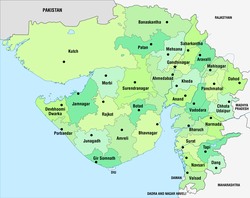| Thol Lake Thol Bird Sanctuary | |
|---|---|
 Flamingos and a black winged stilt in Thol Lake | |
| Location | Thol village near Kalol,Kadi,Mehsana District, Gujarat |
| Coordinates | 23°22.50′N72°37.50′E / 23.37500°N 72.62500°E |
| Lake type | Lentic |
| Catchment area | 15,500 hectares (38,000 acres) |
| Basin countries | India |
| Surface area | 699 hectares (1,730 acres) |
| Water volume | 84 million cubic metres (3.0×109 cu ft) |
| Frozen | |
| Official name | Thol Lake Wildlife Sanctuary |
| Designated | 5 April 2021 |
| Reference no. | 2458 [1] |
Thol Lake is an artificial lake near Thol village in Kadi in Mehsana District in the Indian state of Gujarat. A fresh water lake surrounded by marshes, it was built as an irrigation tank in 1912. Declared the Thol Bird Sanctuary in 1988, it is a habitat to 150 species of birds, about 60% of them waterbirds. Many migratory birds nest and breed in the lake and its periphery. The two most prominent species of birds recorded in the sanctuary are flamingoes and sarus crane (Grus antigone). [2] [3] The sanctuary is also proposed to be declared an Eco-Sensitive Zone, conforming to the Environment (Protection) Act, 1986 (29 of 1986), for which draft notification has been prepared. [4]




